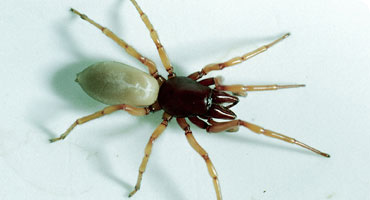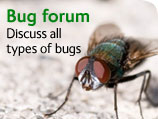Woodlouse spider, Dysdera crocata
Body size
Female to 15mm; male to 10mm.
Appearance
Distinctive, with prominent jaws, an absence of hairs, and a reddish carapace and legs, contrasting with a cream or grey-coloured abdomen (photo).
Habitat, range and season
In and around buildings and under debris. Emerges from hiding places on nocturnal hunting excursions; woodlice are its main prey. Originally a native of southern Europe; now introduced to Japan, N and S America, S Africa, Australia and New Zealand. Adults throughout the year.
Web
None.
First recorded in the UK
1861.
Bite reports
'Held on to top of finger, had to be knocked off; the bite was like that of a bee sting, leaving a white spot on finger.'
'Similar to a nettle sting. The pain subsided after an hour, leaving a red mark and 2 tiny puncture marks which persisted for a couple of days.'
'Suffered papular urticaria.'
'Knuckles swollen, weal patch.'


